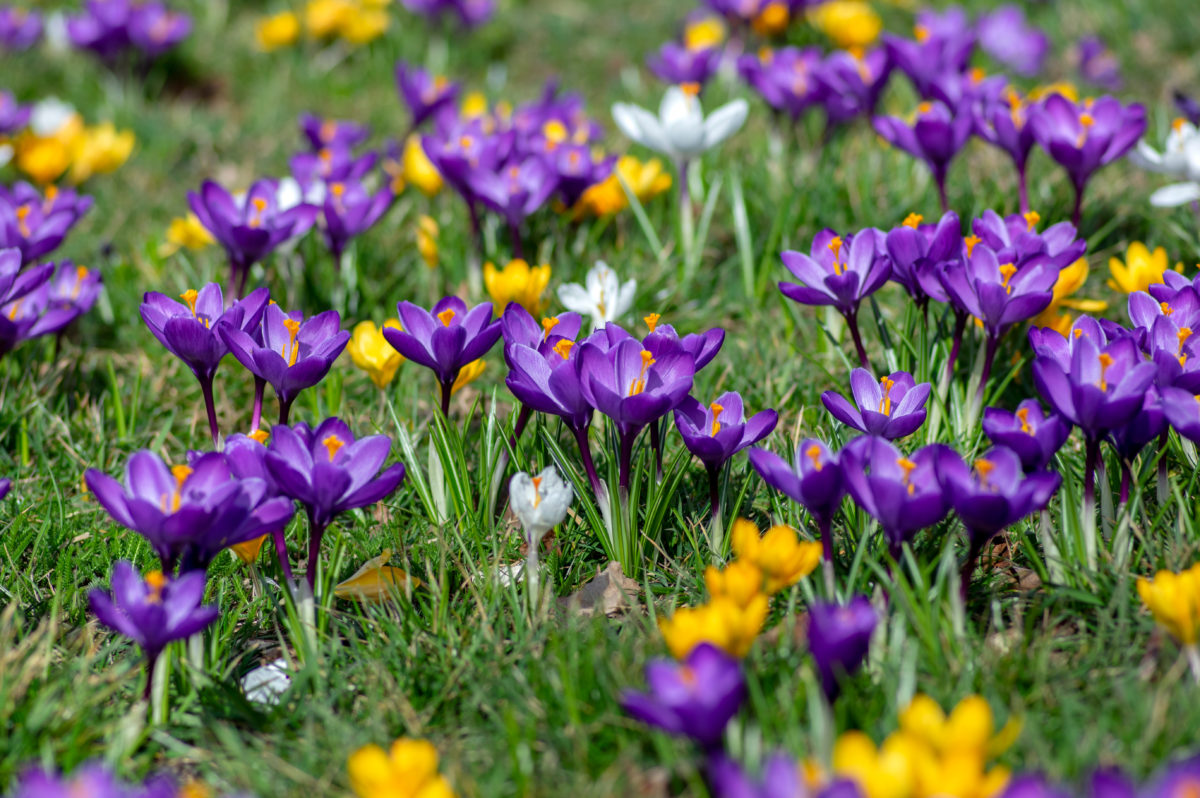
When we published the article on low-maintenance lawn alternatives on Blooming Backyard, we had a great response from our online community on Facebook.
It warms my heart to know that more and more people are realizing how detrimental lawns are. I also know that replacing a lawn is out of reach for some of our readers, often due to lack of time, a lack of know-how, or just being a renter.
What if there was a middle way? Namely, naturalizing bulbs in a lawn.
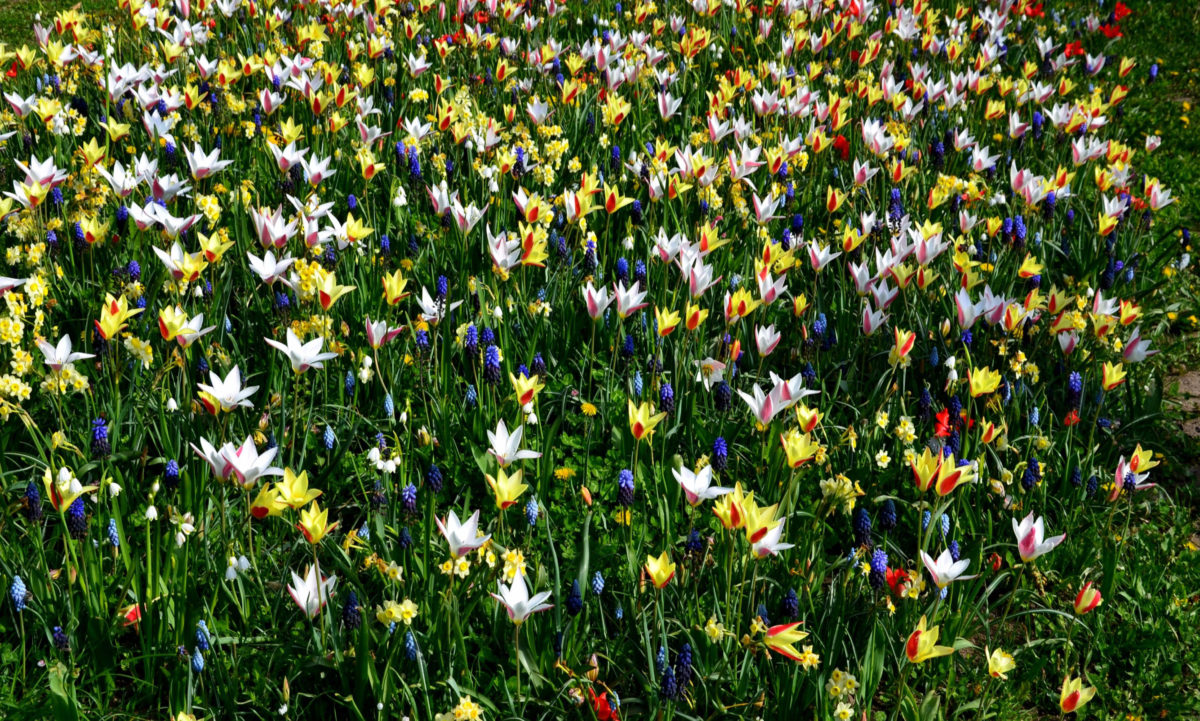
Tulip, daffodils and muscari will turn any lawn into a work of art.
Imagine your lawn blooming into a colorful carpet of flowers when the snow melts in the spring.
Wouldn’t it be wonderful to be able to admire a meadow of blue, white, yellow, pink, cream and purple beauty for six-to-eight weeks, instead of having to look at a drab lawn in mid-March?
Since you’ll have to delay mowing (more on that later), maybe a naturalized bulb lawn will turn out to be the gateway to replacing your lawn altogether.
What does naturalizing bulbs even mean?
The term “naturalized bulbs” was originally used in botany to refer to bulbs that grow and multiply freely in nature. If you’ve ever seen meadows full of crocuses or clearings in the woods where snowdrops take over in the spring, you’ll know what this means.
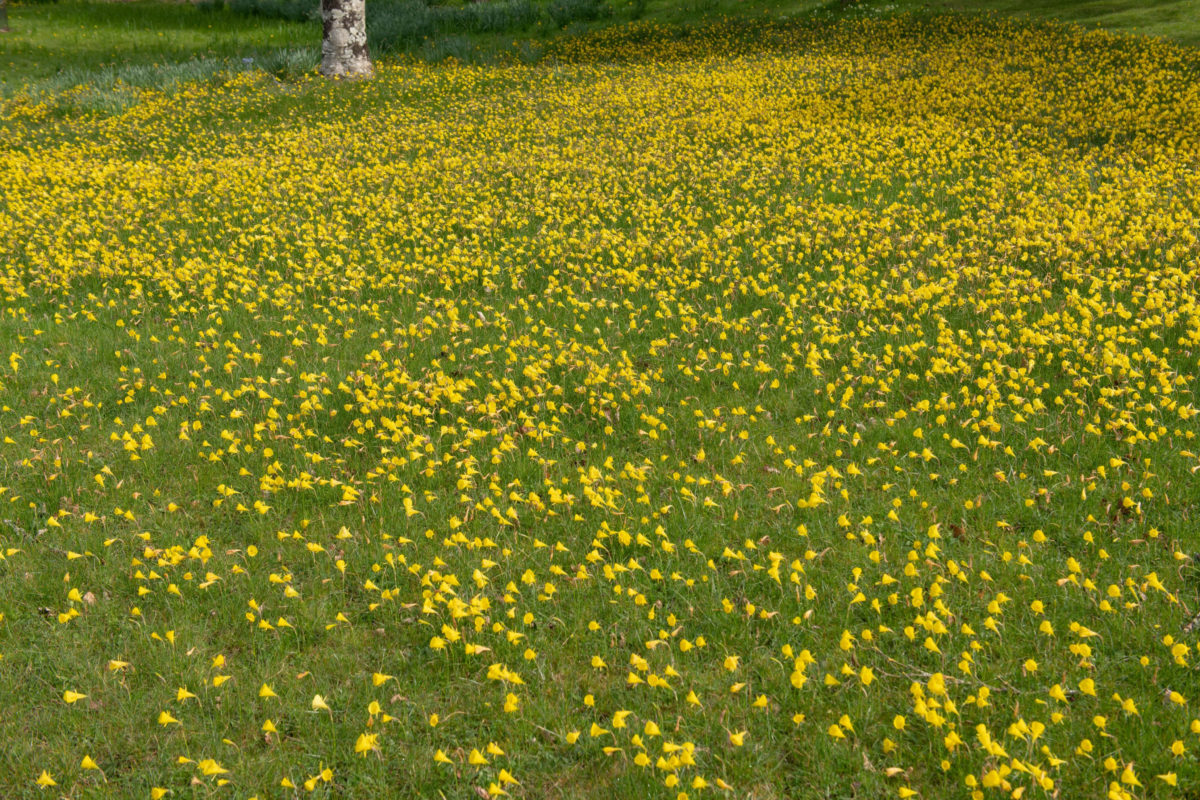
In our backyards, naturalized bulbs only need human intervention to get them started. But once the bulbs are planted, there’s no maintenance necessary. You don’t need to dig out the bulbs after they’re done blooming to store them over the winter (a task some gardeners prefer to do in their bulb flower beds). You don’t need to pre-sprout the bulbs and you definitely don’t need to apply any fertilizers. In fact, “set it and forget it” is a good rule of thumb for the bulbs in your lawn. The bulbs will gradually divide to cover more area, so in that respect, they’re as low maintenance as it gets.
When should I plant bulbs in my lawn?
Since you’ll be planting early spring bloomers, you should always do it in the fall, when the temperature is cool enough, but the soil hasn’t frozen yet.
Spring bulbs need the soil temperature to stay below 60F (about 16C), so October and November are good months to plant in most USDA zones and their equivalents.
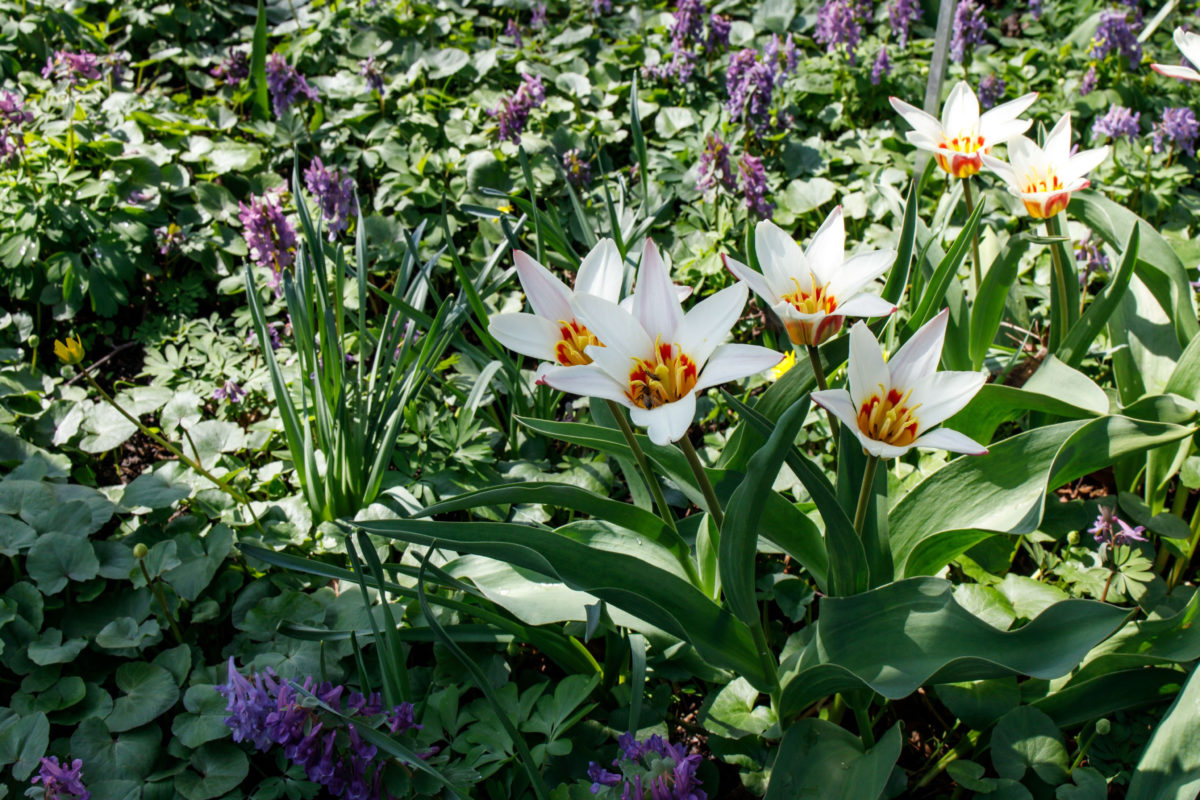
Even if you’re used to starting your blooms in early spring, you should still plant blooms in your lawn in the fall. First, because the bulbs most suitable for a lawn require at least a 12-to-16- week chilling period in order to bloom and they’re very early bloomers (crocuses and snowdrops pop out as early as January and February in some climates). Secondly, your lawn might still be too frozen in late winter to allow for easy planting.
How do I plant bulbs in my lawn?
A popular piece of advice is to just throw the bulbs in the air and plant them wherever they land to get that naturally scattered look. You could do that, if you wanted to play “find the needle in the haystack.” This method may work well with larger bulbs; or maybe it works for people who have better eyesight than me. But try that with tiny crocus bulbs and you’ll still be out there looking for where the bulbs landed come spring.
What I found works is just to scatter them at no more than three feet in front of you, or just place them directly where you’d like them to grow.
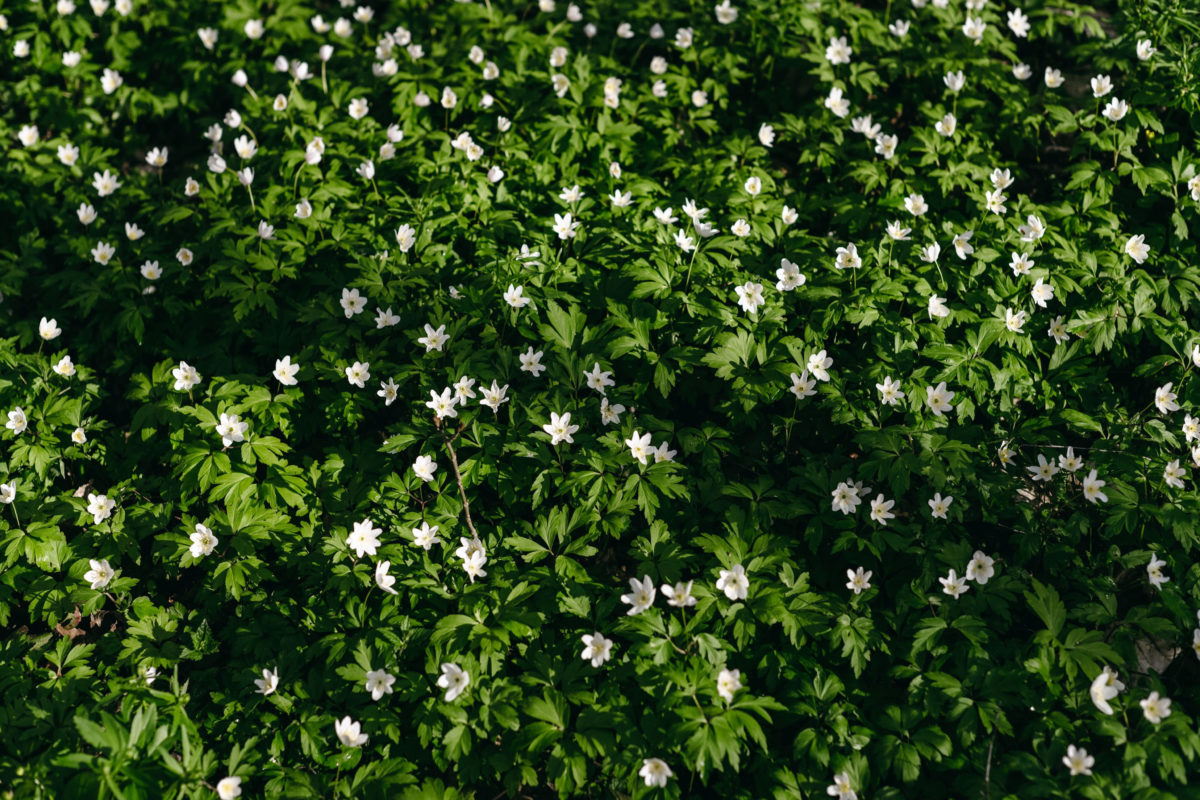
About ten small bulbs per square foot of lawn should be enough to get you started. If you want a tighter-looking blooming pattern, you can increase that to fifteen bulbs. Don’t exert yourself. You can always plant more in the fall for next year’s display.
Depending on your preference (and your level of patience), you can either scatter the bulbs around (gradually, planting as you go, just to make sure you find them again) or you can plant them in a group (with about a foot in-between groups).
How to plant scattered bulbs
You can use a trowel for this task, but with so many bulbs to get into the ground, a bulb planter is a better tool and can be picked up online pretty cheaply.
Think of this tool as the gardening equivalent of an apple corer. Simply dig in with the bulb planter and remove a piece of turf and the soil underneath it.
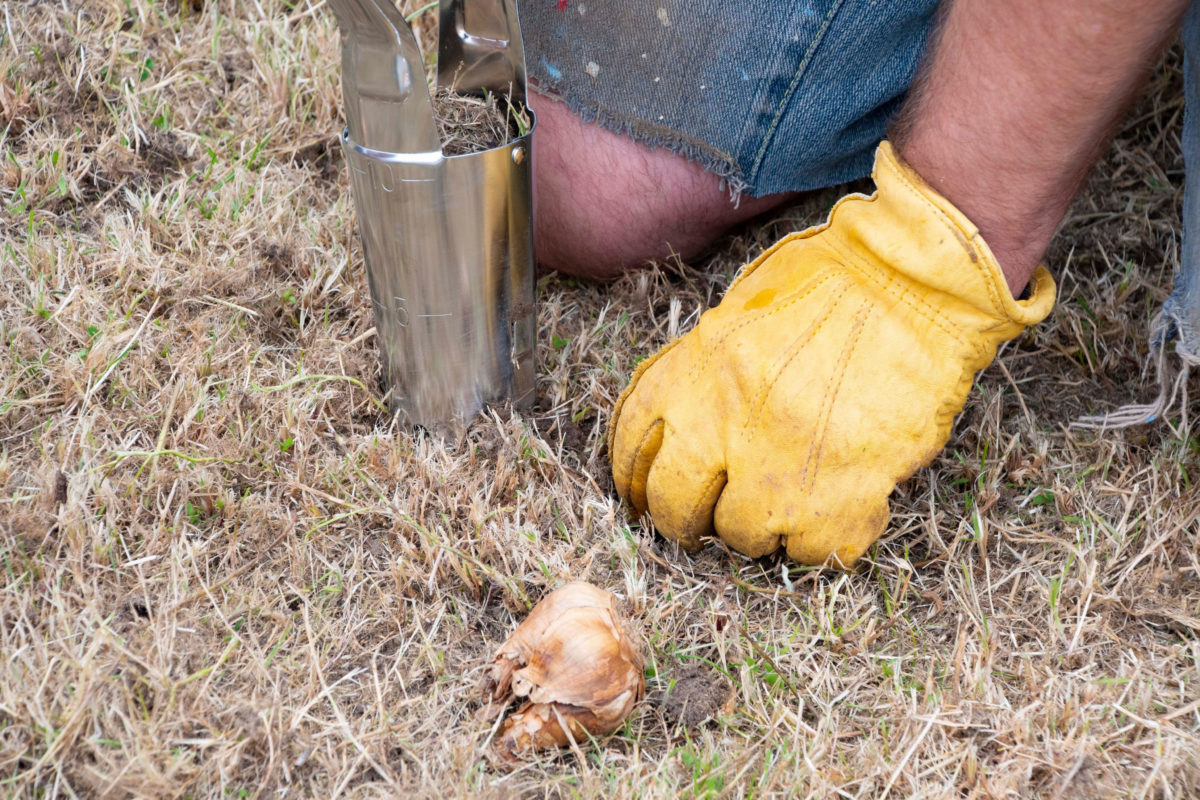
Plant the bulb about three times its own depth, pointing up, then plug the soil that you’ve removed back in. You might have to lightly compress the ground now that you’ve added the height of a bulb to the mix, but don’t stomp on it too hard. Repeat until you reach your desired pattern.
My main tip for this method is not to cover the holes as soon as you’ve placed the bulbs in the ground. Plant all the bulbs in one go, so you can see their spacing, then cover them all at the same time.
How to plant bulbs in groups
Planting bulbs in tighter groups is an easier way to get bulbs naturalized in the garden. You won’t have to dig as many holes if you simply batch-plant your bulbs in groups of 15 or 20, for example.
Using a shovel, cut out about a square foot of turf, then lift it and set it aside. Plant your desired number of bulbs in the soil that you’ve just exposed.
Remember, the bulbs have to be buried about three times their height. If in doubt, just stack three bulbs on top of each other in the hole, then remove the top two and the one you’re left with will be at the right depth.
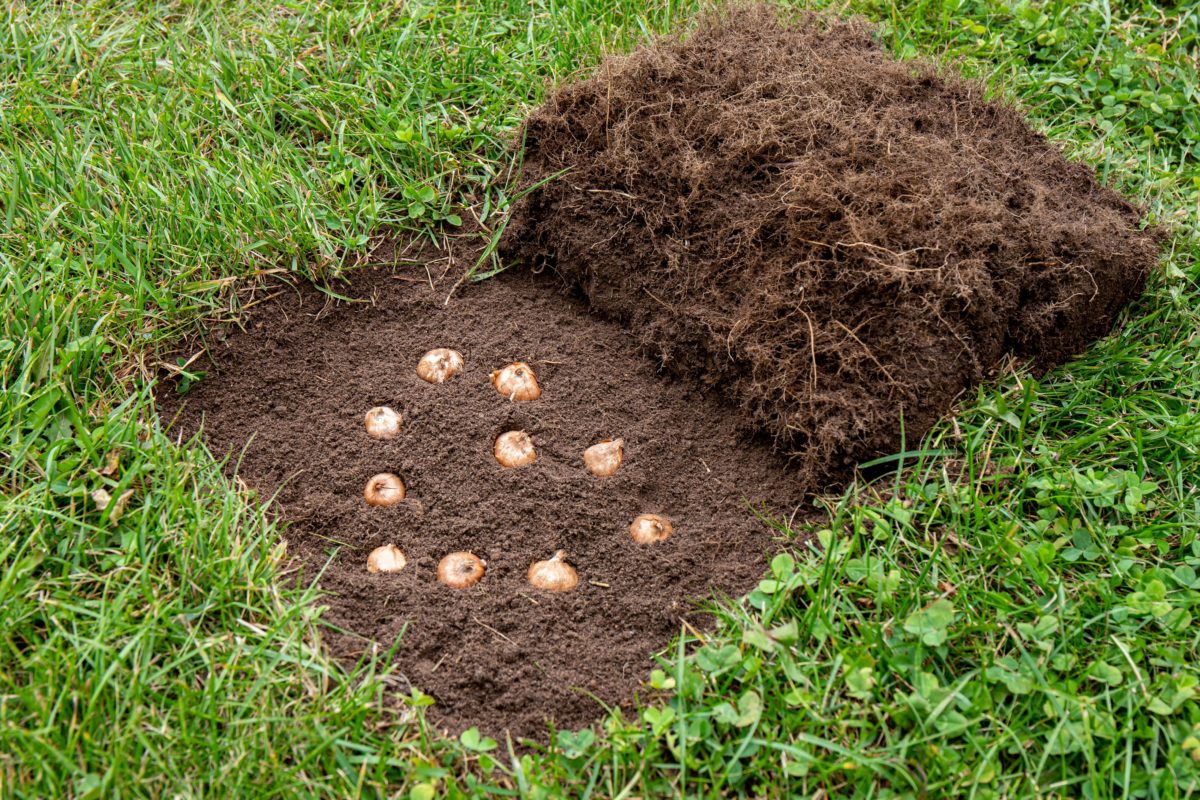
The next step is to add as many bulbs as you want to the hole, as long as you leave some space for them to multiply over the coming years. A good rule of thumb is spacing them about three times the width of the bulb. Once you’ve done that, replace the turf over the bulbs, press it lightly and water it thoroughly to help the bulbs get established.
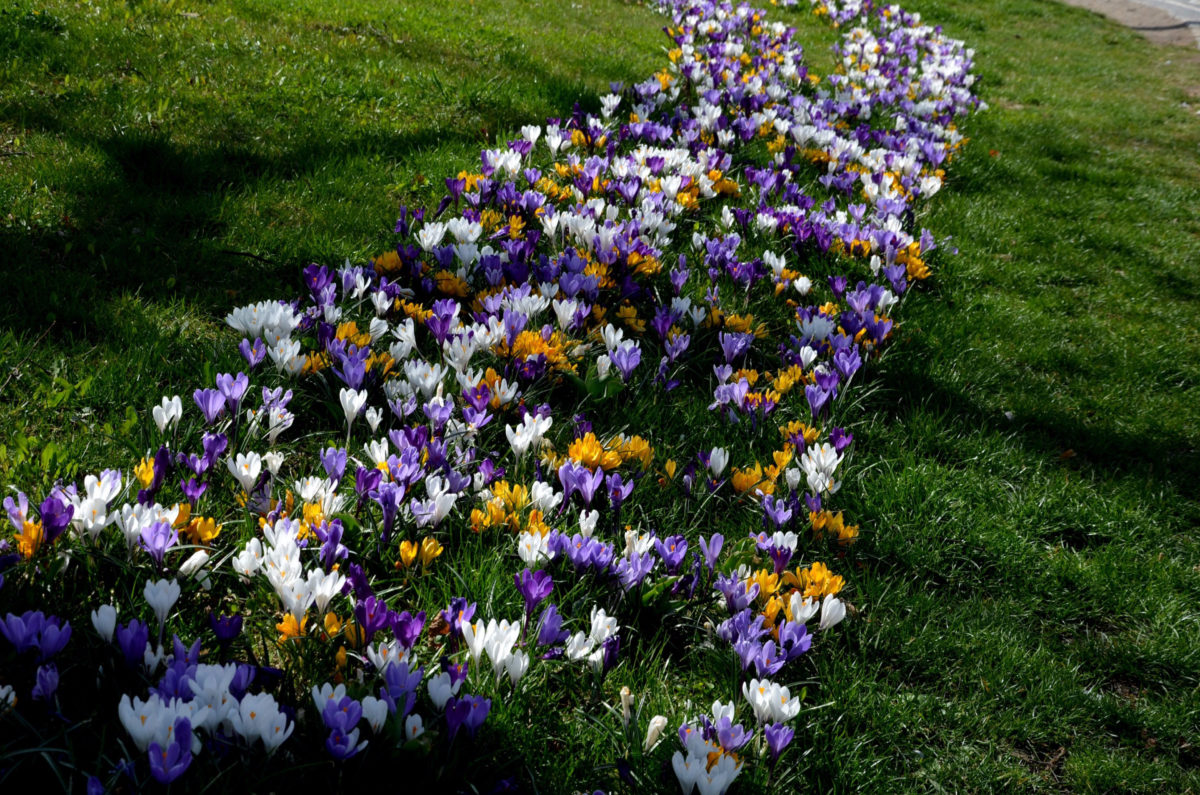
The nice thing about the method is that it allows you to mix and match the bulbs in a few ways. You can plant the same bulb in a group, or different bulbs with different bloom times. You can also plant one color (again, multiple types of bulbs) or a combination of two or more colors.
How do I care for the bulbs I’ve planted in my lawn?
As I mentioned before, the bulbs in your lawn don’t need much maintenance. The same goes for your lawn, at least if you want bulbs to come back next year. Don’t overfertilize your lawn and don’t apply any herbicides.
Most bulbs will thrive in full sun, although there are bulbs (particularly woodland ones, such as crocuses, bluebells, snowdrops and fritillaria) that can prefer some shade.
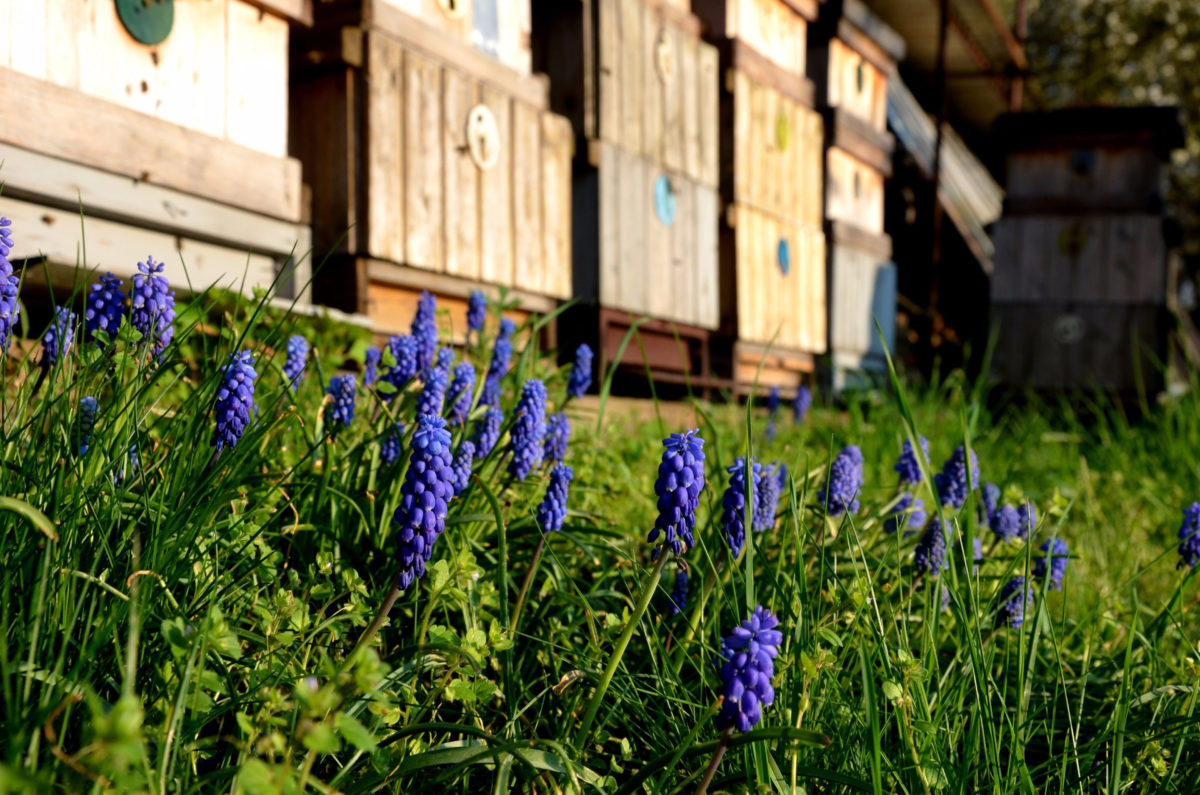
When you first plant your bulbs, you should keep the lawn well-watered (but not soggy) in order to help the plants get established and grow roots. You don’t need to keep watering them every summer though, since the precipitation they get over the winter months should be enough to sustain the growth from now on.
Once the flowers are gone, you’ll be left with the leaves. I love the variety of bulb foliage, but some lawn purists don’t like it. Whatever you do, don’t remove the foliage until it turns yellow or brown. Bulbs use their leaves to store up energy for next year’s bloom. Think of the leaves as solar batteries. You can’t expect a device to still be working after you remove the batteries, can you?
The same goes for bulbs, so your initial investment and work will have been in vain if you mow down the leaves prematurely. For most early spring bulbs, it will take at least six weeks of “sun charging” before the leaves start drying out. You know the plant doesn’t need the leaves anymore when you can gently tug it and it comes right off. That’s when you can resume your summer mowing routine. Or not.
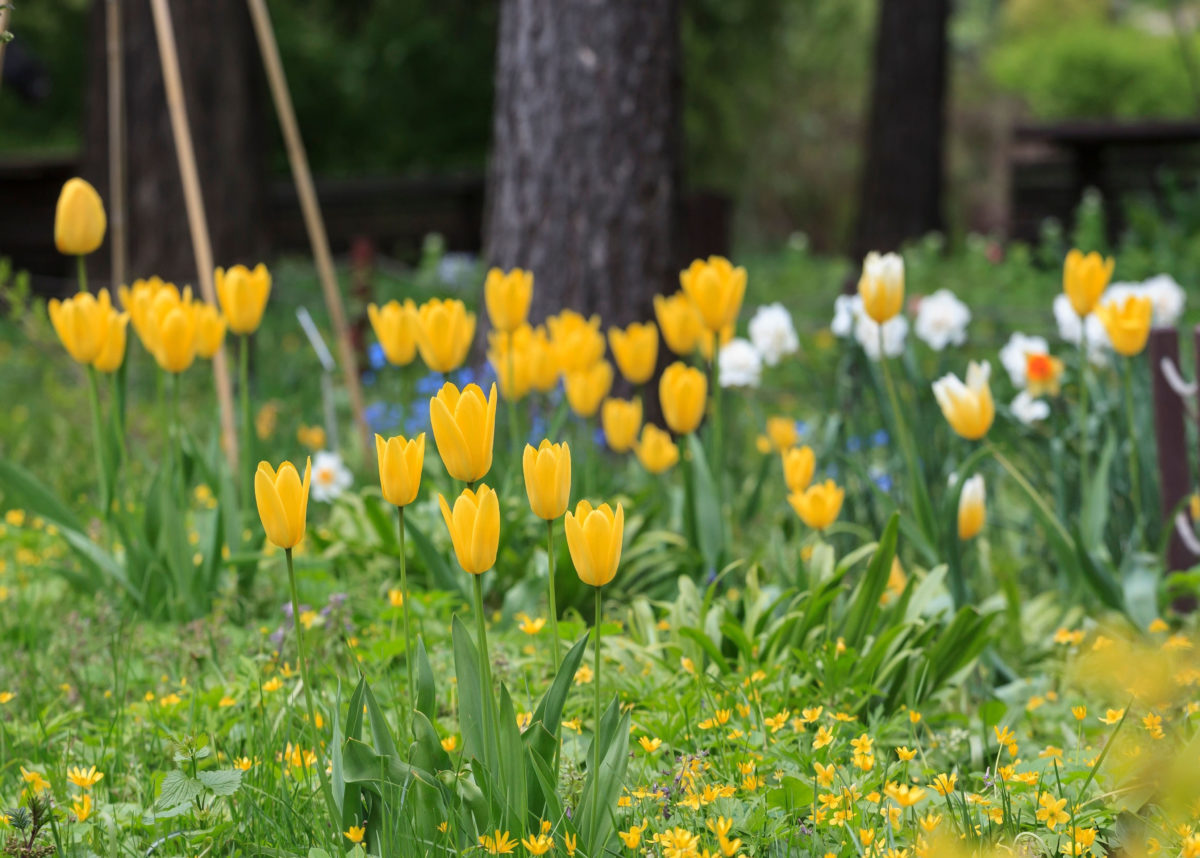
Do I need to replant the bulbs in my lawn every year?
No, you don’t need to replace or replant the bulbs. However, I don’t think I’ve ever planted the right amount of bulbs on my first try. Even when I keep my estimations on the conservative side, I tend to overestimate how much area a bag of bulbs will cover. If you have the same problem, you can add more bulbs to your lawn next fall. But keep in mind that bulbs will divide over time, so while you’ll be adding some, Mother Nature will also be adding more every year.
What kind of bulbs should I choose for my lawn?
In bulb catalogs or their online equivalents, you’ll often see the mentions “suitable for naturalizing” or “naturalizes well” or something along those lines next to certain bulbs. You can mix and match these to your heart’s content to personalize your lawn’s palette.
And here’s a word of advice from my own experience – don’t wait too long to order bulbs in late summer, since early spring bloomers go fast. And with some suppliers, the earlier you place your order, the better your chances of getting healthy sturdy bulbs. You don’t want to be left with the runts.
But just to get you started, here are 10 plants that will naturalize well in your lawn.
1. Snowdrops (Galanthus)
Snowdrops are the first flowers you’ll see poking out from under the snow, often as early as January in a temperate climate. Snowdrops are members of the Amaryllis family, although unlike the boastful red amaryllis, they’ll stay small and delicate.
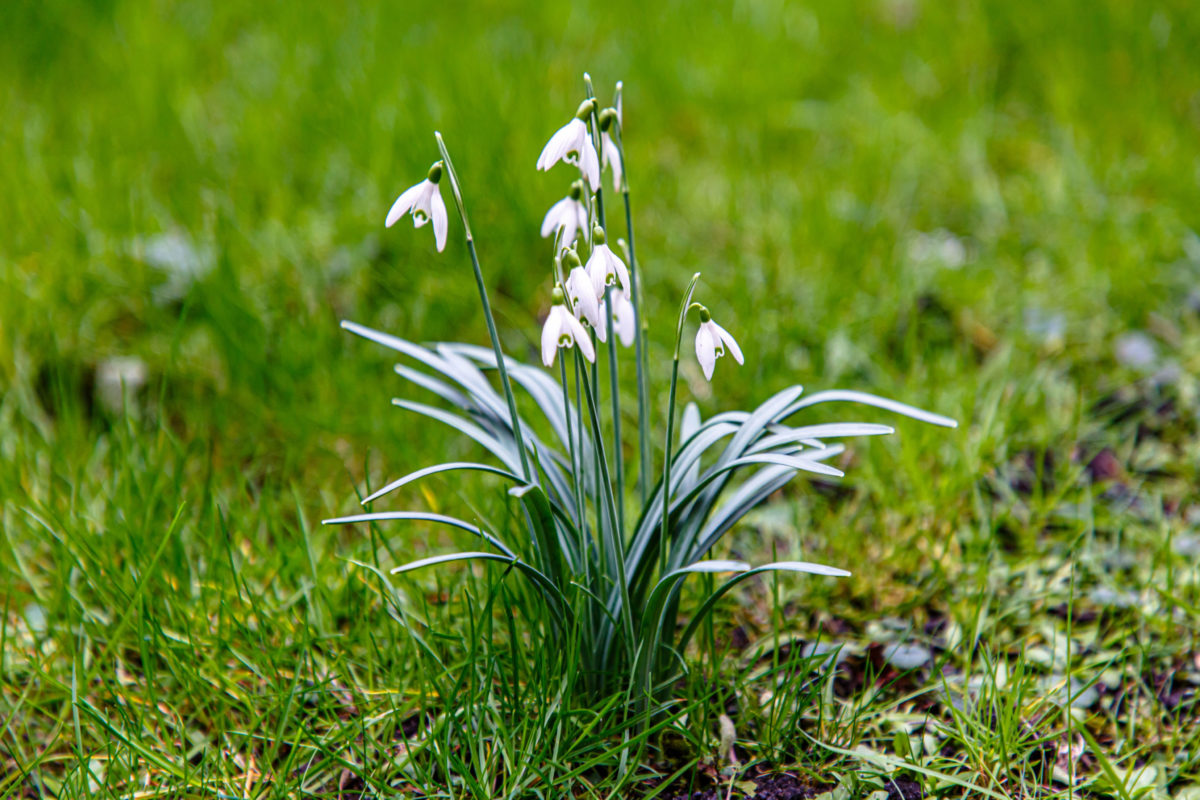
Snowdrops prefer shaded areas, so they’re perfect for the parts of the lawn that don’t get too much sun in early spring. They can also be planted in the lawn under trees, in large masses or scattered around. For snowdrops to bloom the temperature in the winter needs to go below 20F, so this bulb might not be the best option if you live in a warm climate.
There are only about a dozen cultivated species of snowdrops, according to the Chicago Botanic Garden, with the common snowdrop (Galanthus nivalis) and the giant snowdrop (Galanthus elwesii, up to 16 inches tall) being the most popular.
2. Crocus (Crocus)
Crocuses are right up there with snowdrops in terms of how early they pop up early in the year. Crocuses are very resistant to low temperatures, so you’ll often see a crocus patch with a full head of snow thriving in late winter gardens.
Unlike snowdrops (that don’t have much pollen available) crocuses provide an early source of food for pollinators. Once the blooms are gone, spring-blooming crocuses leave behind elegant sharp blades of grass-like leaves that will blend in beautifully with your lawn.
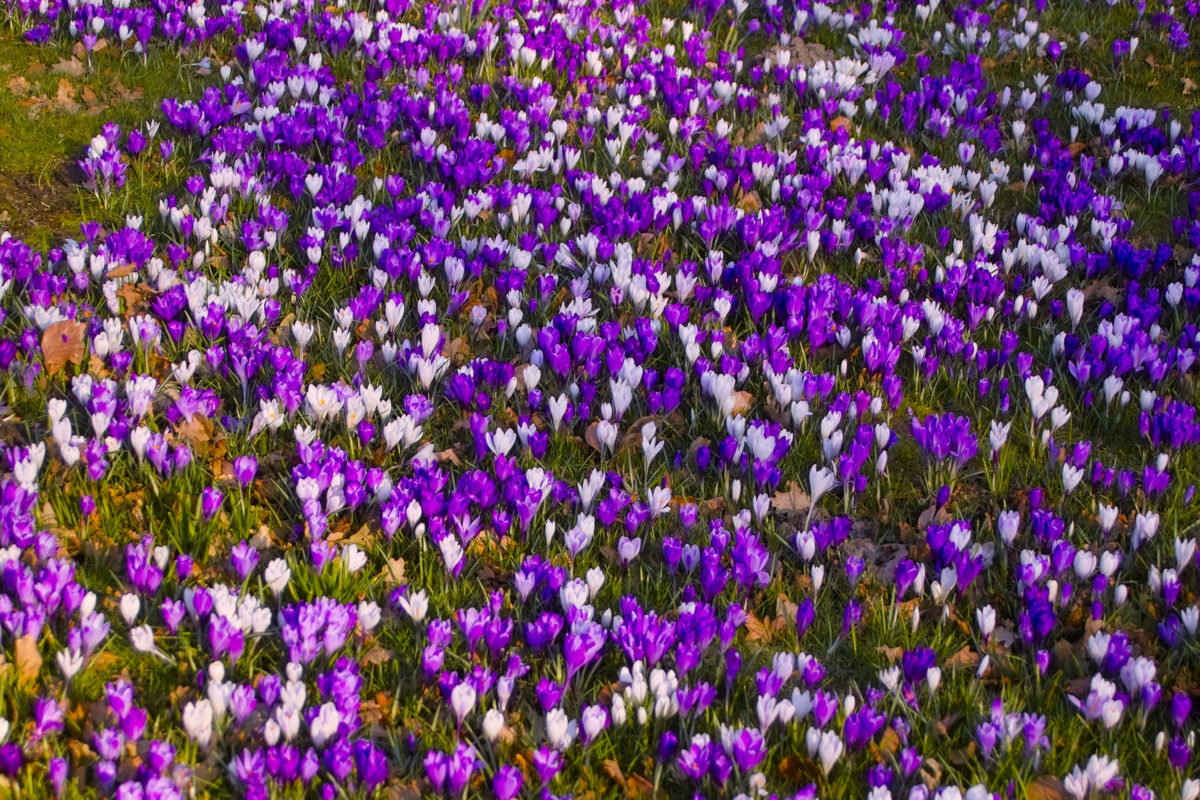
Even though you may be thinking of purple patches when you think of crocuses, these flowers come in a variety of colors, ranging from white to yellow, silvery and even light pink.
To get you started, look for:
Crocus tommasinianus ‘Lilac Beauty’
Crocus tommasinianus ‘Ruby Giant’
Crocus tommasinianus ‘Barr’s Purple’
Crocus bifloris (also known as the Scottish crocus) – some varieties do bloom in the fall, so check the packaging before you plant them.
Crocus chrysanthus ‘Blue Pearl’ – white on the inside and blue on the outside.
Crocus chrysanthus ‘Romance’ – creamy white flowers with dark markings around the bottom
Crocus ancyrensis ‘Golden Bunch’ (also known as the Turkish crocus) – bright yellow on the inside as well as the outside.
3. Grape hyacinths (Muscari)
Some gardeners call these plants “grape hyacinths” due to the bunch-like pattern of the flowers. I prefer to call them muscari, just to avoid confusion and because I think they look nothing like hyacinths.
Muscari thrive in full sun, but they also do well in part shade, so planting them where the sun doesn’t reach in the winter isn’t a problem for this low-maintenance plant.
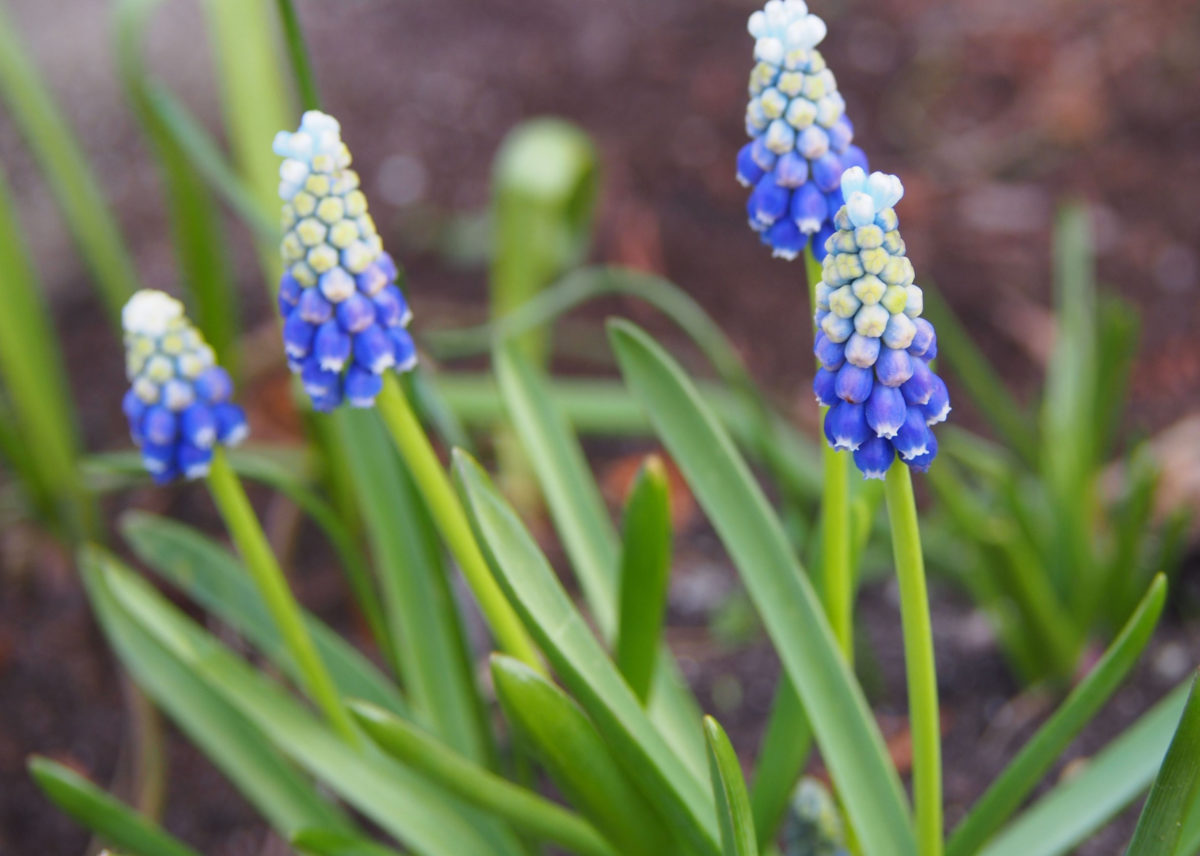
Muscari multiplies very quickly if you don’t disturb it, as long as it’s planted in well-draining soil. Depending on your climate and your site, muscari will bloom from mid-March up until late May. Muscari have a very subtle floral fragrance that some people liken to that of grape juice.
The most popular variety for garden use is Muscari armeniacum, with its myriad of cultivars in shades of purple, blue and white. A more compact version, Muscari botryoides, is also popular with gardeners.
Here are a few cultivars that will naturalize well in your lawn:
Muscari armeniacum ‘Siberian Tiger’ – bright white flowers with a compact growth
Muscari armeniacum ‘Pink Sunrise’ – light pink flowers
Muscari armeniacum ‘Aqua Magic’ – baby blue flowers
Muscari botryoides ‘Album’ – creamy white
Muscari aucheri ‘Ocean Magic’ – bright blue with lighter tops
Muscari armeniacum ‘Mount Hood’ – ice-blue florets with white tops
Muscari armeniacum ‘Valerie Finnis’ – chalky purple
But you don’t have to choose just one, since most bulb suppliers also sell muscari in assorted bags for a richer display or color and an extended blooming season.
4. Miniature daffodils (Narcissus)
There are so many varieties of daffodils to choose from, but the ones best suited for naturalizing in a lawn are the miniature ones (also called “dwarf daffodils,” although I’m happy to notice this nickname is going out of style).
While the taller daffodils look beautiful in borders and garden beds, the miniature ones blend better in a lawn, especially if you’re mixing them with other bulbs. However, you can stick to planting just daffodils, as long as you mix and match more cultivars for a more pleasant display.
Daffodils do well in full sun and can bloom in early, middle or late spring. They are prolific growers and expand to fill in the lawn very quickly, as long as the soil isn’t too clay-heavy.
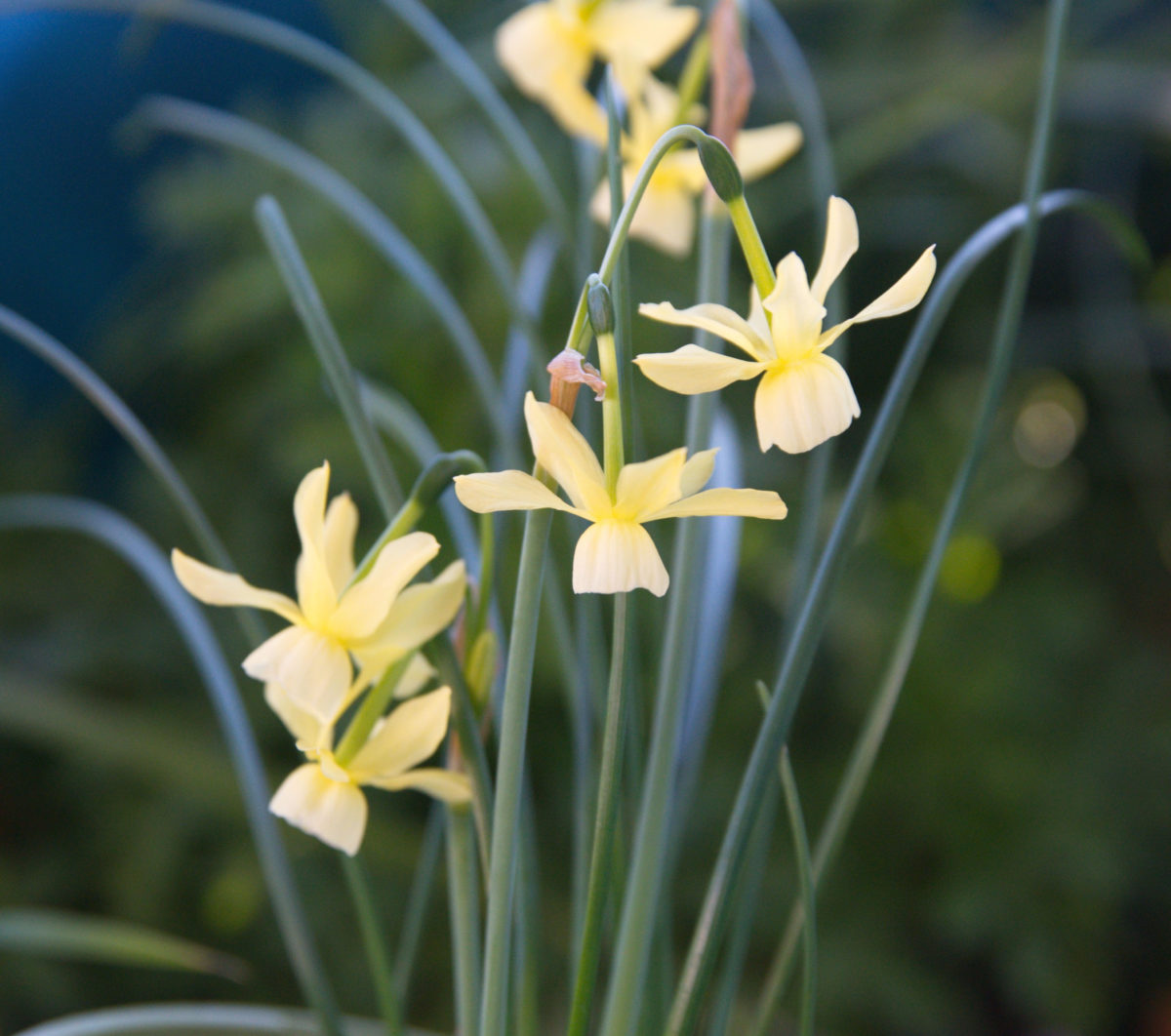
Here’s a list of miniature cultivars from the American Daffodil Society (opens as a PDF). Unfortunately, the list isn’t accompanied by plant photos, but that only makes for a nice evening indoors looking at daffodil catalogs online in the fall, doesn’t it? A few cultivars that I think look beautiful include:
Narcissus ‘Tete-a-tete’
Narcissus ‘Atlas Gold’
Narcissus ‘Minnow’
Narcissus ‘Kokopelli’
Narcissus ‘Thalia’
Narcissus ‘Pipit’
Narcissus ‘Jetfire’
Narcissus ‘Angel’s Breath’
Narcissus ‘Rapture’
Narcissus ‘Hummingbird’
Narcissus ‘Scarlet Gem’ – not a miniature, but recommended by the American Daffodil Society for naturalizing
5. Tulips (Tulipa)
Unlike daffodils, a lot of the tulips that have been hybridized only do well for up to five years. Gradually, the tulip bulbs will lose their vigor and the blooms will get smaller every year. However, tulips that have been hybridized from wild tulips (also known as “species tulips”) don’t have this problem.
Species tulips need full sun or part sun and well-drained soil but should be planted in an area of your lawn that doesn’t get too much soaking in the summer.
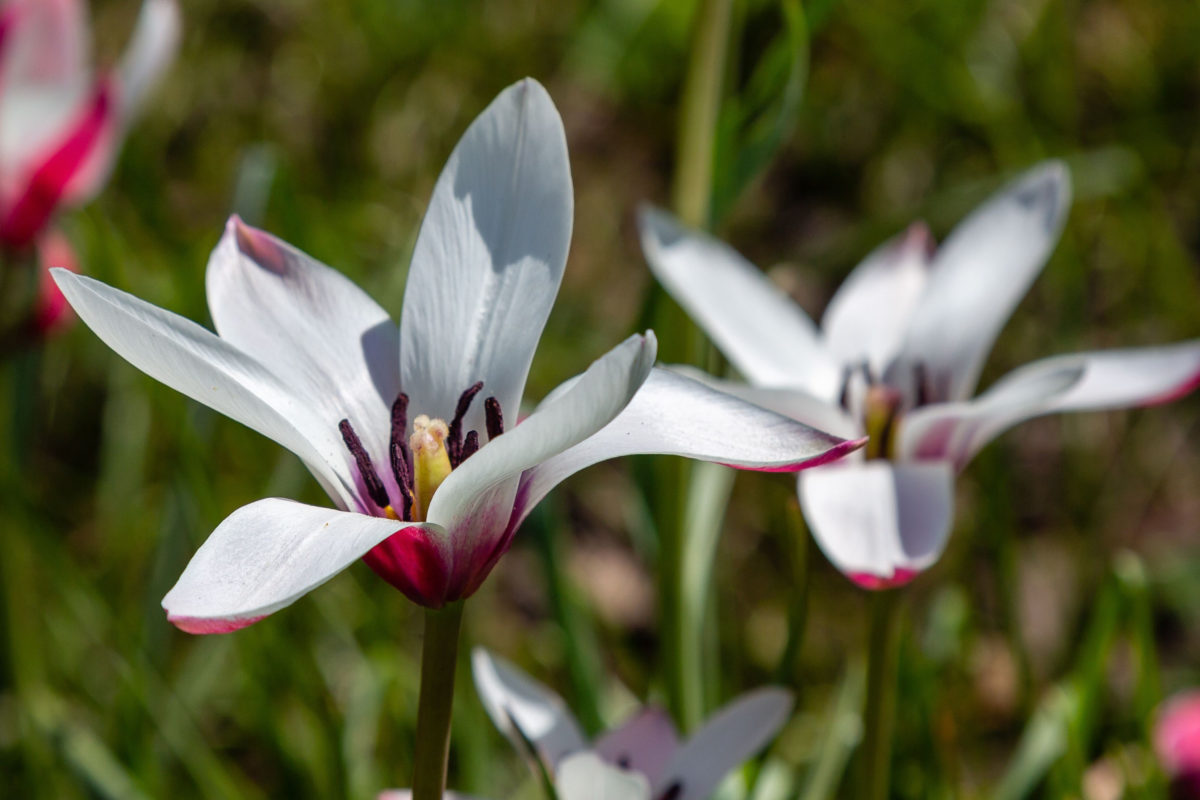
Look for the following species tulips for a mix of colors and bloom times:
Tulipa pulchella ‘Persian Pearl’ – cyclamen on the outside and yellow on the inside
Tulipa bakerii ‘Lilac Wonder’ – lilac-pink petals with a yellow center
Tulipa sylvestris ‘Wild Woodland’ – bright yellow
Tulipa clusiana ‘Peppermint Stick’ – a candy cane-like combination of red and white
Tulipa batalinii ‘Bronze Charm’ – different shades of peachy cream
6. Wood anemone (Anemone nemorosa in Europe or Anemone quinquefolia in North America)
The wood anemone (or windflower) is a very understated plant with elegant white flowers that grow well in dappled shade. The flowers open to receive the warmth of the sun (and follow the sun’s progression in the sky) but close when it’s dark or rainy.
If you see this plant in the wild, it’s an indication that you’re standing on what used to be woodland. However, there are over 70 cultivars that have been bred for garden use, so never remove wood anemone from its natural habitat.
Although it technically doesn’t grow from bulbs, but from rhizomes, the wood anemone is easy to naturalize in lawns and it’s an early-season source of food for pollinators.
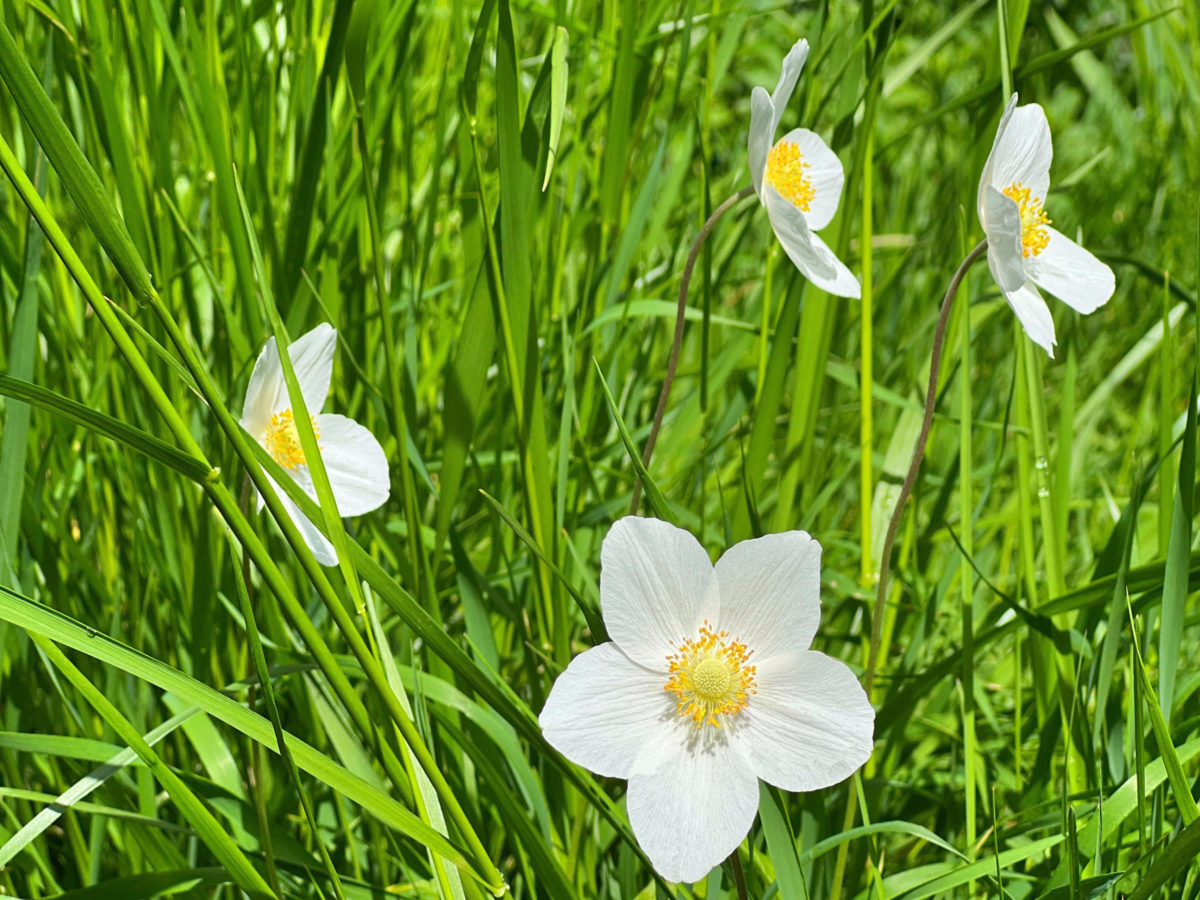
Most wood anemones are white, with Anemone nemorosa ‘Vestal’, ‘Alba Plena’ and ‘Blue Eyes Double-Flowered’ as popular varieties.
If you’re after for a bit of color in your lawn, have a look at:
Anemone nemorosa ‘Robinsoniana’ – pale lavender-blue,
Anemone nemorosa ‘Cedric’s Pink’ – shades of pastel pink
Anemone nemorosa ‘La Rochanne’ – white with a pink confetti-like pattern
7. Dog-tooth violet (Erythronium)
Dog-tooth violet (also known as trout lily) is a perennial plant in the lily family that grows from bulbs (actually, corms) in mid-to-late spring.
Despite its nickname, it bears no relation to violets. This plant is native to woodlands, so it can tolerate shade very well. In fact, it’s one of the most common sights in shade gardens. When you naturalize it in a lawn, keep in mind that it has to be planted in moist rich soil, so definitely not a good addition to dry patches of lawn. It also needs good drainage.
The corms of the dog-tooth violet plant aren’t very large, and they’re quite sensitive to cold. So you should plant them deeper than the usual recommended depth for bulbs (about four inches deep or more, depending on how cold your winter gets).
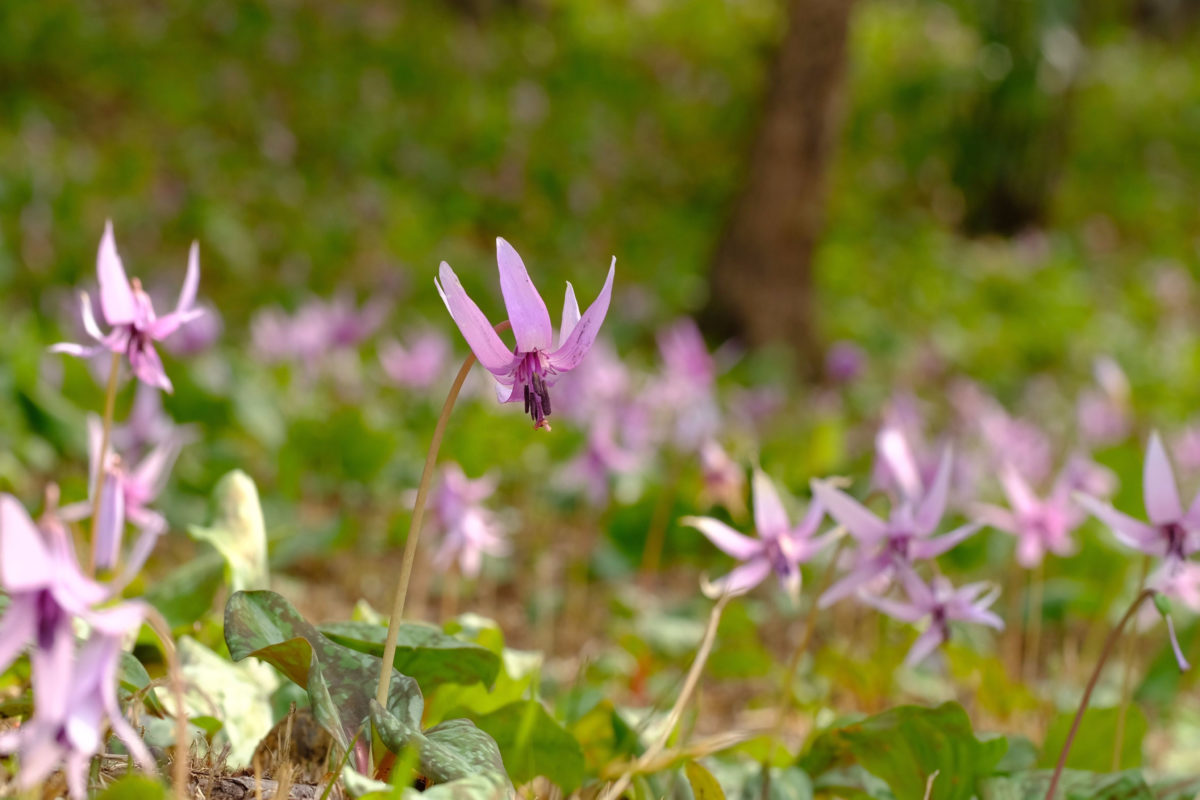
Because these plants may take a couple of years to reach maturity and maximum bloom, always plant them in clumps of three or more to ensure a thicker coverage. Erythronium is a favorite with bees and other pollinators in mid-spring.
Like all bulbs, the mottled foliage of the dog-tooth violet will die back in the summer and come back the following spring.
The most popular dog-tooth violet is Erythronium ‘Pagoda’ which has bright yellow flowers and dappled brownish-green leaves. You can mix it with Erythronium ‘White Beauty’ (bright white) Erythronium ‘Janice’ (light pink) or Erythronium ‘Joanna’ (pink-yellow) for a colorful carpet of blooms.
8. Miniature irises (Iris reticulata)
If you’re thinking there’s no way you’d grow irises in your lawn, you’ll reconsider when you see how adorable miniature irises are. These early-season bloomers are easy to naturalize and they’ll happily multiply if they get enough water and sun.
Miniature irises grow anywhere between 4-6 inches tall (about 10-15 centimeters) in shades of purple and yellow, with grass-like leaves that dry out in the summer. Their season ends just when the bearded iris season begins, so if you time it right, you’ll have irises growing in your garden for months.
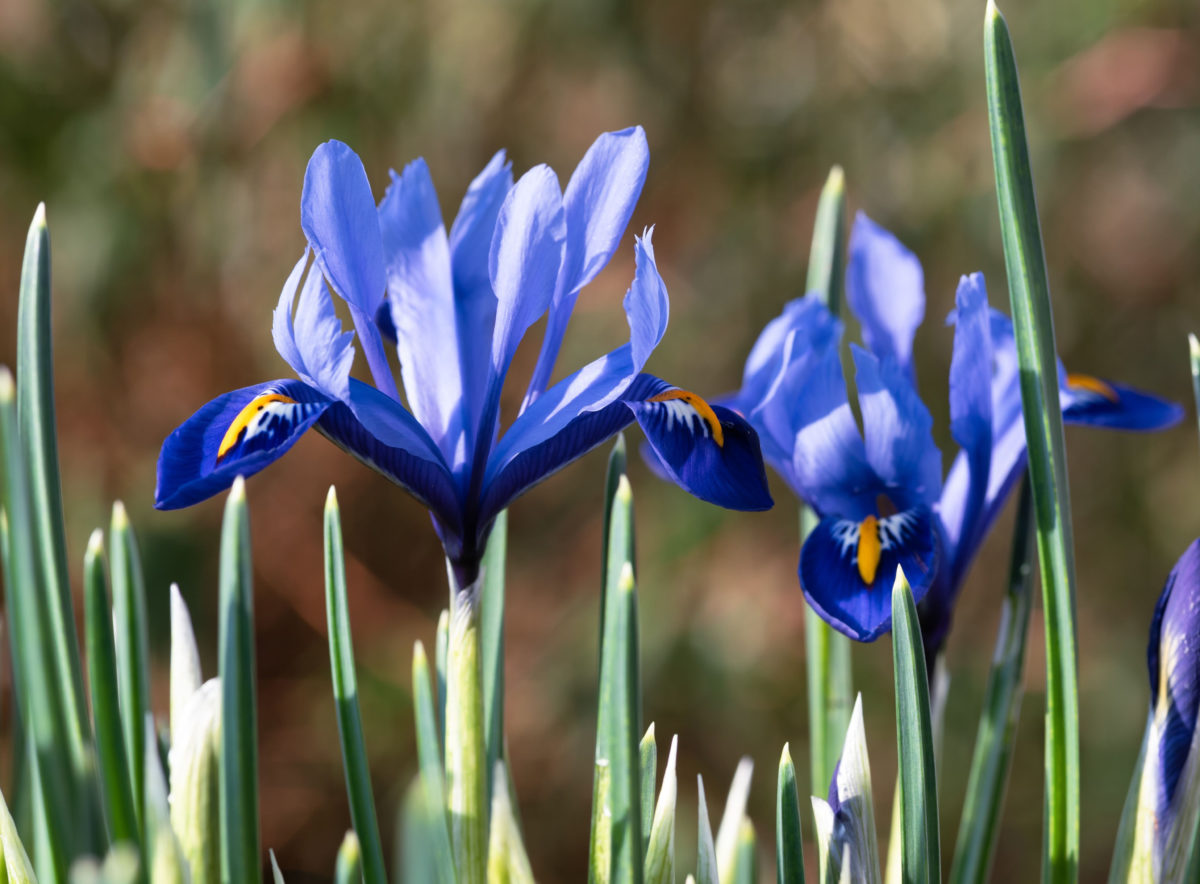
Iris reticulata have a subtle fragrance that mixes well with that of hyacinths and daffodils. There are so many beautiful cultivars to choose from, but how about starting with these:
Iris reticulata ‘Joyce’ – blue and gold
Iris reticulata ‘Harmony’ – deep blue exterior that fades into light blue
Iris reticulata ‘Gecko Echo’ – white and gold
Iris reticulata ‘African Wine – deep burgundy
Iris reticulata ‘Beetlejuice’ – white with mauve frills
Iris reticulata ‘Sea Breeze’ – bright flowers with white tips
9. Corydalis
The trumpet-like flowers that grow almost perpendicular to the ferny foliage make this unusual-looking plant a hanging basket favorite. But corydalis also look stunning against a green grass background and will naturalize well in your lawn.
The best way to jumpstart corydalis in your lawn is by plugging in starters and keeping them moist until they develop roots. Although corydalis isn’t a bulb per se, it has the same blooming and spreading pattern as bulbs.
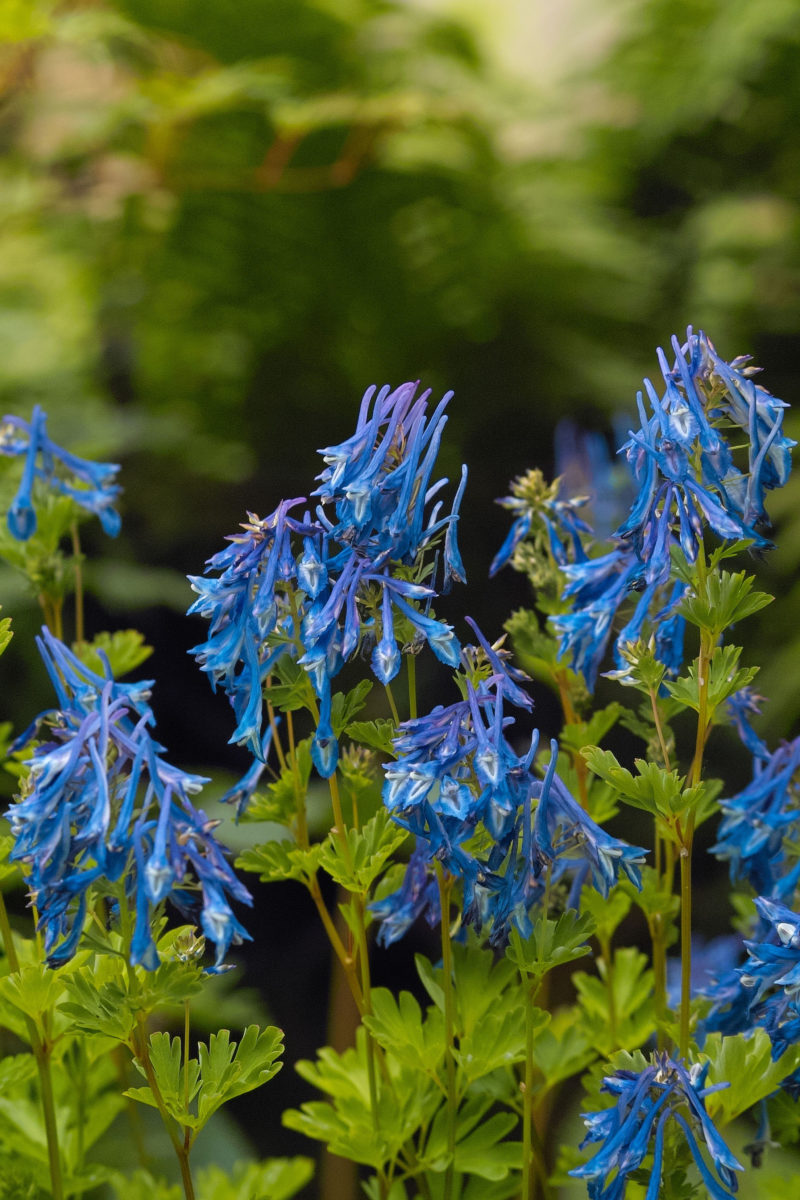
Corydalis does well in well-drained soil and prefers dappled shade to full sun. In fact, hot sun will slow down its growth.
Corydalis ‘Fumewort’ (raspberry-pink), Corydalis ‘Blue Panda’ (baby blue) and Corydalis ‘Lutea’ (creamy yellow) will add a burst of color to your lawn in late spring and early summer.
10. Snake’s head fritillary (Fritillaria)
This is such a fierce name for such a delicate flower, but you can see the resemblance as soon as you set your eyes on the Fritillaria meleagris.
Fritillaria is an early-season bloomer that comes in a variety of colors, with the most common being burgundy, dark purple, white and red. Most fritillaria blooms have confetti-like dots that make them look like mini-disco balls in the glowing sun.
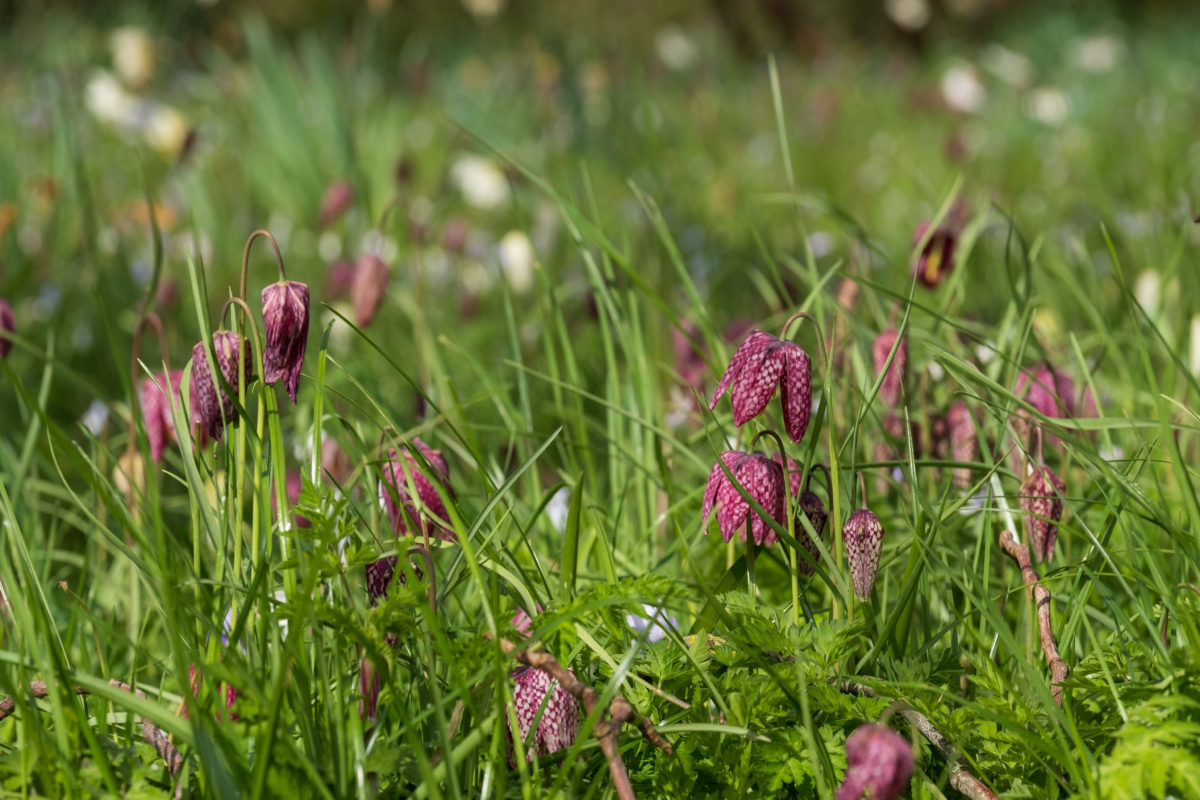
Since it’s originally a woodland bulb, this plant grows well in morning sun followed by afternoon shade. It can also handle full shade, although it might not bloom as early in the spring.
The Meleagris varieties of fritillaria will only grow up to ten inches, making them perfect for blending in a spring lawn. The taller varieties (‘Crown Imperial’ and ‘Persica’) will look better in a spring garden bed rather than in a lawn.
Start your collection with Fritillaria ‘Uva Vulpis’ (dark purple on the outside and yellow on the inside) and Fritillaria meleagris ‘Alba’ (creamy white flowers)
One of the best aspects of naturalizing bulbs in your lawn is, without a doubt, how easy it is to be creative and try different combinations (of colors, types of bulbs or even cultivars within the same species).
